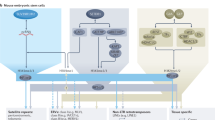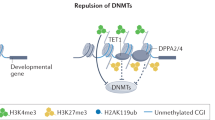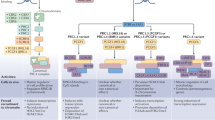Abstract
The trithorax and the polycomb group proteins are chromatin modifiers, which play a key role in the epigenetic regulation of development, differentiation and maintenance of cell fates1,2,3. The polycomb repressive complex 2 (PRC2) mediates transcriptional repression by catalysing the di- and tri-methylation of Lys 27 on histone H3 (H3K27me2/me3)3. Owing to the essential role of the PRC2 complex in repressing a large number of genes involved in somatic processes, the H3K27me3 mark is associated with the unique epigenetic state of stem cells4,5,6,7. The rapid decrease of the H3K27me3 mark during specific stages of embryogenesis and stem-cell differentiation indicates that histone demethylases specific for H3K27me3 may exist. Here we show that the human JmjC-domain-containing proteins UTX and JMJD3 demethylate tri-methylated Lys 27 on histone H3. Furthermore, we demonstrate that ectopic expression of JMJD3 leads to a strong decrease of H3K27me3 levels and causes delocalization of polycomb proteins in vivo. Consistent with the strong decrease in H3K27me3 levels associated with HOX genes during differentiation, we show that UTX directly binds to the HOXB1 locus and is required for its activation. Finally mutation of F18E9.5, a Caenorhabditis elegans JMJD3 orthologue, or inhibition of its expression, results in abnormal gonad development. Taken together, these results suggest that H3K27me3 demethylation regulated by UTX/JMJD3 proteins is essential for proper development. Moreover, the recent demonstration that UTX associates with the H3K4me3 histone methyltransferase MLL2 (ref. 8) supports a model in which the coordinated removal of repressive marks, polycomb group displacement, and deposition of activating marks are important for the stringent regulation of transcription during cellular differentiation.
This is a preview of subscription content, access via your institution
Access options
Subscribe to this journal
Receive 51 print issues and online access
$199.00 per year
only $3.90 per issue
Buy this article
- Purchase on Springer Link
- Instant access to full article PDF
Prices may be subject to local taxes which are calculated during checkout




Similar content being viewed by others
References
Ringrose, L. & Paro, R. Polycomb/Trithorax response elements and epigenetic memory of cell identity. Development 134, 223–232 (2007)
Schuettengruber, B., Chourrout, D., Vervoort, M., Leblanc, B. & Cavalli, G. Genome regulation by polycomb and trithorax proteins. Cell 128, 735–745 (2007)
Schwartz, Y. B. & Pirrotta, V. Polycomb silencing mechanisms and the management of genomic programmes. Nature Rev. Genet. 8, 9–22 (2007)
Boyer, L. A. et al. Polycomb complexes repress developmental regulators in murine embryonic stem cells. Nature 441, 349–353 (2006)
Bracken, A. P., Dietrich, N., Pasini, D., Hansen, K. H. & Helin, K. Genome-wide mapping of Polycomb target genes unravels their roles in cell fate transitions. Genes Dev. 20, 1123–1136 (2006)
Lee, T. I. et al. Control of developmental regulators by polycomb in human embryonic stem cells. Cell 125, 301–313 (2006)
Surani, M. A., Hayashi, K. & Hajkova, P. Genetic and epigenetic regulators of pluripotency. Cell 128, 747–762 (2007)
Issaeva, I. et al. Knockdown of ALR (MLL2) reveals ALR target genes and leads to alterations in cell adhesion and growth. Mol. Cell. Biol. 27, 1889–1903 (2007)
Klose, R. J. & Zhang, Y. Regulation of histone methylation by demethylimination and demethylation. Nature Rev. Mol. Cell Biol. 8, 307–318 (2007)
Shi, Y. & Whetstine, J. R. Dynamic regulation of histone lysine methylation by demethylases. Mol. Cell 25, 1–14 (2007)
Christensen, J. et al. RBP2 belongs to a family of demethylases, specific for tri-and dimethylated lysine 4 on histone 3. Cell 128, 1063–1076 (2007)
Cloos, P. A. et al. The putative oncogene GASC1 demethylates tri- and dimethylated lysine 9 on histone H3. Nature 442, 307–311 (2006)
Greenfield, A. et al. The UTX gene escapes X inactivation in mice and humans. Hum. Mol. Genet. 7, 737–742 (1998)
Dietrich, N. et al. Bypass of senescence by the polycomb group protein CBX8 through direct binding to the INK4A-ARF locus. EMBO J. 26, 1637–1648 (2007)
Lee, V. M. & Andrews, P. W. Differentiation of NTERA-2 clonal human embryonal carcinoma cells into neurons involves the induction of all three neurofilament proteins. J. Neurosci. 6, 514–521 (1986)
Bracken, A. P. et al. The Polycomb group proteins bind throughout the INK4A-ARF locus and are disassociated in senescent cells. Genes Dev. 21, 525–530 (2007)
Brenner, S. The genetics of Caenorhabditis elegans . Genetics 77, 71–94 (1974)
Bracken, A. P. et al. EZH2 is downstream of the pRB-E2F pathway, essential for proliferation and amplified in cancer. EMBO J. 22, 5323–5335 (2003)
Rappsilber, J., Ishihama, Y. & Mann, M. Stop and go extraction tips for matrix-assisted laser desorption/ionization, nanoelectrospray, and LC/MS sample pretreatment in proteomics. Anal. Chem. 75, 663–670 (2003)
Timmons, L., Court, D. L. & Fire, A. Ingestion of bacterially expressed dsRNAs can produce specific and potent genetic interference in Caenorhabditis elegans . Gene 263, 103–112 (2001)
Acknowledgements
We are grateful to U. Toftegaard and R. Christensen for expert technical assistance. We thank T. Stiernagle for her continuing assistance with strain requests. We also thank the C. elegans reverse genetic core facility, Vancouver, Canada, for the production of the mutant alleles. We thank members of the Helin and Rappsilber laboratories for technical advice and support. P.A.C.C. was supported by the Benzon Foundation, and D.P. by a post-doctoral fellowship from the Danish Medical Research Foundation. A Marie Curie Excellence Grant from the European Commission supported J.R. The work in the Helin laboratory was supported by grants from the Danish Cancer Society, the Novo Nordisk Foundation, the Danish Medical Research Council, the Danish Natural Science Research Council, the Danish National Research Foundation, and the International Association for Cancer Research.
Author information
Authors and Affiliations
Corresponding author
Ethics declarations
Competing interests
Reprints and permissions information is available at www.nature.com/reprints. The authors declare no competing financial interests.
Supplementary information
Supplementary Figures
This file contains Supplementary Figures S1-S6 with Legends. (PDF 629 kb)
Rights and permissions
About this article
Cite this article
Agger, K., Cloos, P., Christensen, J. et al. UTX and JMJD3 are histone H3K27 demethylases involved in HOX gene regulation and development. Nature 449, 731–734 (2007). https://doi.org/10.1038/nature06145
Received:
Accepted:
Published:
Issue Date:
DOI: https://doi.org/10.1038/nature06145
This article is cited by
-
The role of H3K27me3 methylation in cancer development
Genome Instability & Disease (2024)
-
Epigenetic effects of herbal medicine
Clinical Epigenetics (2023)
-
KDM6B protects T-ALL cells from NOTCH1-induced oncogenic stress
Leukemia (2023)
-
Pathogenic bacteria modulate pheromone response to promote mating
Nature (2023)
-
Developmental transcriptomic patterns can be altered by transgenic overexpression of Uty
Scientific Reports (2023)
Comments
By submitting a comment you agree to abide by our Terms and Community Guidelines. If you find something abusive or that does not comply with our terms or guidelines please flag it as inappropriate.



